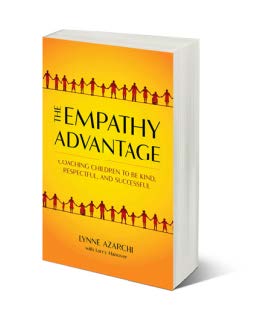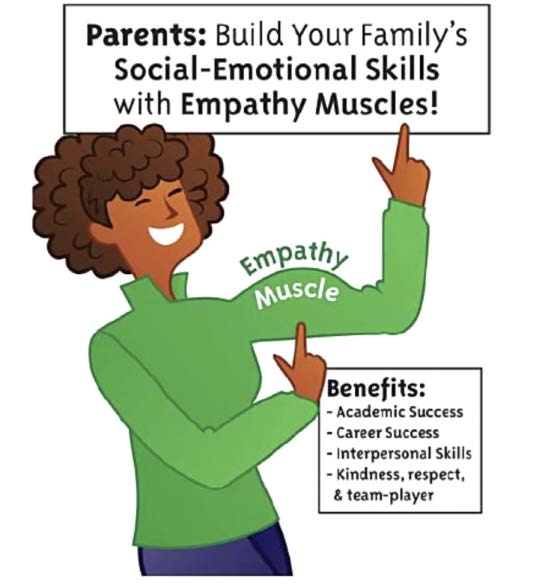BOOK REVIEW
THE EMPATHY ADVANTAGE
COACHING CHILDREN TO BE KIND, RESPECTFUL, AND SUCCESSFUL
REVIEWED BY LAUREN AGORATUS, M.A.
Although this book isn't specifically about children with special needs, it will benefit all children, including those with disabilities and special healthcare needs. There is also information regarding bullying of children with disabilities.
CHAPTER 1: WHY YOU SHOULD CARE ABOUT EMPATHY
It is noted in the preface that racist attitudes and behaviors, for example, can be seen as early as age three. Early and consistent appropriate learning opportunities must be given to children. Teasing, which is sometimes seen as a childhood rite of passage, can follow children over time, well after the event. Lack of empathy may be increasing, as there is an increase in bullying, self-centeredness, and a decline in interaction in person. This is exacerbated by the media, especially the adult media, to which too many children are exposed. The main message of this book is that empathy can be taught. "Empathy can transform 'otherness' into inclusiveness." Without empathy, there is a lack of understanding of differentness and diversity. Too much screen time results in focus only on oneself. Empathy and social emotional skills can help counteract this.
CHAPTER 2: EMPATHY CAN BE TAUGHT
Children can learn not to be bystanders but, rather, UPstanders and stand up for others. They can learn to cheer other children up, not to bully, and how to help others. Children who are targets need to realize that they should be treated respectfully and that they have the power to speak up and get help from adults to make bullying stop. Bystanders need to recognize that doing nothing is wrong and learn what they can do to stop bullying. The Tolerance Center at Kidsbridge uses evidence-based practices utilizing scripts resulting in measurable attitude shifts.
CHAPTER 3: THE SCIENCE AND BIOLOGY OF EMPATHY
The author describes the science behind empathy in animals and humans. Quite simply, empathy is essential for survival of the species. Activities in this chapter include "walking in someone else's shoes."
CHAPTER 4: EMPATHY 101 – DEFINING HOW EMPATHY FITS IN WITH OTHER EMOTIONAL SKILLS
An UPstander is someone who is motivated by empathy and choses to get involved, which is the opposite of a bystander. A good description of empathy is to focus first on listening, then focusing on being listened to. Empathy is seen as the foundation of social-emotional skills. Emotional intelligence is important to get along with all kinds of people, and empathy is part of emotional intelligence. The difference between empathy and sympathy is also discussed.

Title: The Empathy Advantage: Coaching Children to be Kind, Respectful, and Successful
Author: Lynne Azarchi with Larry Hanover
Publisher: Rowman & Littlefield
Publication Date: November 2020
Paperback: 324 pages
ISBN-13: 978-1538143704
Available at: amazon.com and barnesandnoble.com
CHAPTER 5: EMPATHY, MEDIA, AND SOCIAL MEDIA
Children, teens, and young adults average three hours a day on social media. This is time misspent on not interacting in person.
Media violence and "reality" shows desensitize kids. Some children are sleep-deprived due to excessive gaming or social media. Media literacy is one way for children to use critical thinking about what they're seeing. Virtual reality exercises can help students see what it was like for others and can be used to teach empathy.
Tips for families include limiting social media, turning off all communications to avoid disrupting sleep, reducing exposure to violence, and ensuring that what is seen is developmentally appropriate.
CHAPTER 6: PARENT TIPS – STRENGTHENING MORAL COMPASSES
Parents can model appropriate skills for children. "People skills" can be taught, which will also help later with employment. Topics such as physical violence, cheating on tests, etc., can be discussed. Kids seem more distracted and less respectful. Children with appropriate social-emotional skills, including empathy, have less substance abuse, obesity, and criminal activity according to the data. Parent tips include face-to-face talks, which allows children to understand tone of voice, body language, facial expressions, and other nonverbal clues. Empathy can grow over time, and children with this mindset will volunteer to help others. Family meetings and discussing activities such as museum visits, articles read, etc. are helpful. Parental nurturing is key, as children learn empathy when their own emotional needs are met. Cultural empathy can be taught, again, using "walking in another's shoes" activities. Children will also learn that they are more alike than different from others.
CHAPTERS 7-11: TEACHING EMPATHY (ACROSS THE YEARS)
The next four chapters cover teaching empathy based on the child's age. For infant to three years, restrict screen time for toddlers, don't use shaming because shaming communicates that the child is bad, and there shouldn't be toys or food used as bribes as motivation should come from within. From three to six years, reading books (The Little Engine that Could, The Giving Tree, Chicka Chicka Boom Boom), doing puppet shows, praising kindness, teaching self-compassion vs. self-esteem, and sharing toys, will help. For elementary years, children learn by using mindfulness, apologies that are heartfelt, and participating in family meetings. They learn that it is ok to be different and to use people-first language rather than by disability. For middle school years, students learn through historical empathy (e.g. Abe Lincoln), role-plays, and awareness of stereotypes. Finally, for high school years, teens can discuss implications of school shootings, that social emotional skills also improve academic skills, and depression warning signs. They can also learn about social media and privacy rights, First World vs. Third World problems, and community service (food kitchen) vs. service learning (actually going hungry). Teens will learn not to judge by disability and to have appropriate role models (not just celebrities).
CHAPTER 12: EMPATHY - CRITICAL FOR BULLYING PREVENTION
In keeping with not labelling children, the terminology that is used is "target" rather than "victim", and "those who bully or harm" rather than "bully." Children who bully often lack empathy. Activities in which they role-play the role of target and solving the problem helps. Schools can be an ally for bullying prevention. Children who are targeted for bullying need to understand that they don't deserve to be bullied and that the bullying can be stopped.

MUSCLE MEMORY: An illustration from the Chapter 2 of The Empathy Advantage; "Empathy is like building a muscle: it grows stronger and stronger the more it used and exercised."
THE FINAL CHAPTERS
Chapter 13 covers parents' point of view. Chapter 14 goes over self-compassion. Mindfulness and stress-reduction exercises may be helpful. Teens learn to focus on breathing and repeating thoughts such as "May I be happy, may I be safe, may I be at ease." Then they use those phrases while thinking of loved ones, friends, then to those with whom they may have conflict. In this way, they first learn self-acceptance, then empathy towards others. Active listening, and actually getting down to the level of the child at eye level is covered in Chapter 15. Key phrases can be "I hear you" or "tell me more." Parents must be nonjudgmental (unless there is a safety issue.) Chapter 16 discusses gender and empathy. Chapter 17 goes more in depth on social-emotional skills. Chapter 18 covers teaching empathy using documentaries, stories, and pictures. Pets and empathy show up in Chapter 19. Chapter 20 covers heroes and Chapter 21 covers empathy and paying it forward.
All children can benefit from learning empathy, as it is a learned skill. In this world of narcissism, me-me-me, and the era of selfies, children (and adults!) can learn to think of others. This will make them successful in school, relationships, jobs, and life.•
ABOUT THE REVIEWER:
Lauren Agoratus, M.A. is the parent of a young adult with autism and medical complexity. She serves as the State Coordinator for Family Voices-NJ and as the central coordinator in her state's Family-to-Family Health Information Center. FVNJ and F2FHIC are both housed at the SPAN Parent Advocacy Network (SPAN) at spanadvocacy.org.